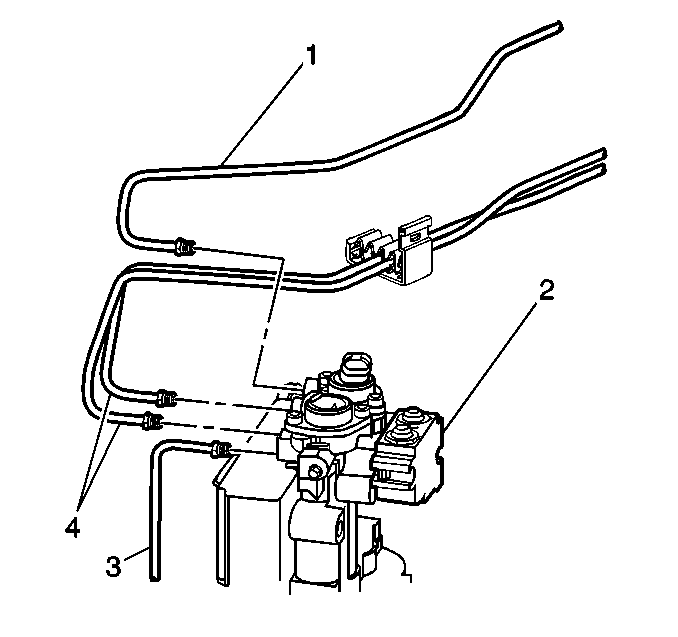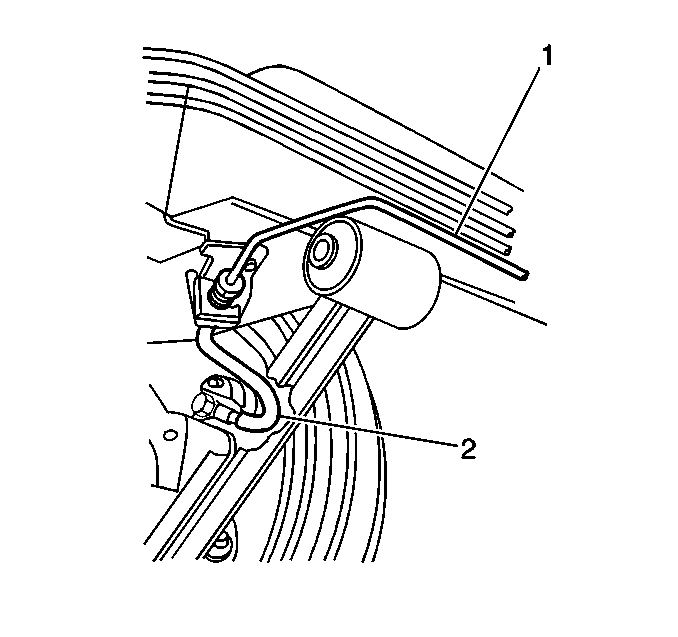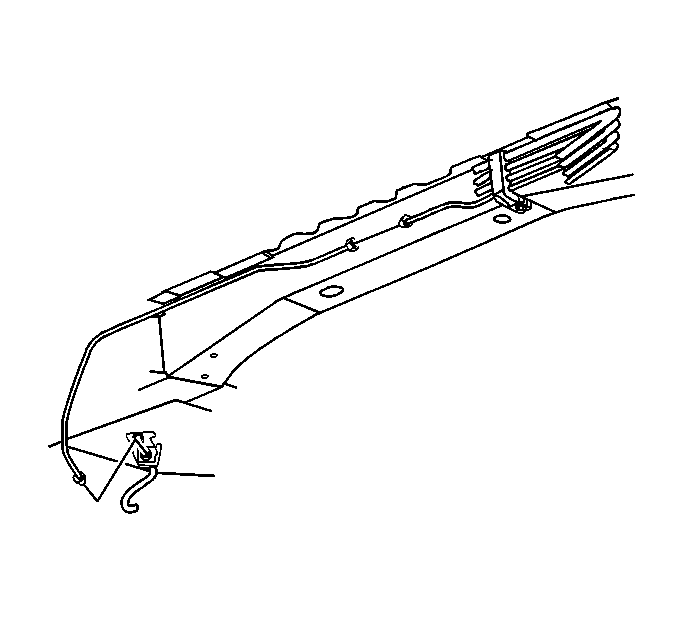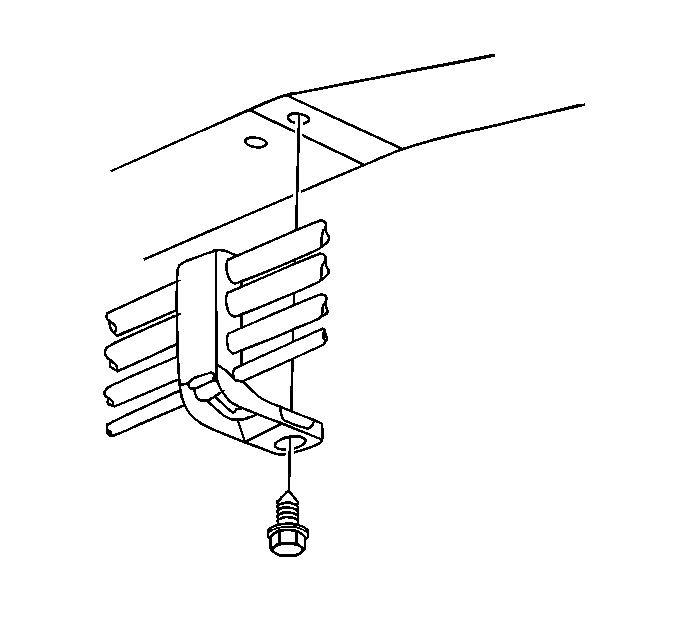Rear Brake Pipe Replacement Left Pipe
Removal Procedure
- Remove the battery. Refer to Battery Replacement in Engine Electrical.
- Remove the battery tray.
- Remove the air cleaner assembly. Refer to Air Cleaner Assembly Replacement -2.4L, Air Cleaner Assembly Replacement -3.1L or Air Cleaner Assembly Replacement -3.1L (LG8) in Engine Controls.
- Disconnect the brake pipe (4) from the brake modulator assembly (2).
- Raise the vehicle. Refer to Lifting and Jacking the Vehicle in General Information.
- Remove the tire and wheel. Refer to Tire and Wheel Removal and Installation in Tires and Wheels.
- Disconnect the brake pipe (1) from the brake hose (2).
- Disconnect the retainers as needed.
- Remove the brake pipe (1).

Caution: Unless directed otherwise, the ignition and start switch must be in the OFF or LOCK position, and all electrical loads must be OFF before servicing any electrical component. Disconnect the negative battery cable to prevent an electrical spark should a tool or equipment come in contact with an exposed electrical terminal. Failure to follow these precautions may result in personal injury and/or damage to the vehicle or its components.

Installation Procedure
Caution: Always use double-walled steel brake pipe when replacing brake pipes. The use of any other pipe is not recommended and may cause brake system failure. Carefully route and retain replacement brake pipes. Always use the correct fasteners and in the original location for replacement brake pipes. Failure to properly route and retain brake pipes may cause damage to the brake pipes and brake system resulting in personal injury.
- Fabricate a new brake pipe. Refer to ISO Flares Replacement .
- Install the brake pipe to the vehicle.
- Loosely install the brake pipe nut to the brake hose (2).
- Lower the vehicle.
- Loosely install the brake pipe nut to the brake modulator assembly (2).
- Install the tire and wheel. Refer to Tire and Wheel Removal and Installation in Tires and Wheels.
- Install the battery tray.
- Install the battery. Refer to Battery Replacement in Engine Electrical.
- Install the air cleaner assembly. Refer to Air Cleaner Assembly Replacement -2.4L, Air Cleaner Assembly Replacement -3.1L or Air Cleaner Assembly Replacement -3.1L (LG8) in Engine Controls.
- Bleed the brake system. Refer to Hydraulic Brake System Bleeding


Notice: Use the correct fastener in the correct location. Replacement fasteners must be the correct part number for that application. Fasteners requiring replacement or fasteners requiring the use of thread locking compound or sealant are identified in the service procedure. Do not use paints, lubricants, or corrosion inhibitors on fasteners or fastener joint surfaces unless specified. These coatings affect fastener torque and joint clamping force and may damage the fastener. Use the correct tightening sequence and specifications when installing fasteners in order to avoid damage to parts and systems.
Tighten
Tighten the brake pipe nuts to 27 N·m (20 lb ft)
Rear Brake Pipe Replacement Right Pipe
Removal Procedure
- Remove the battery. Refer to Battery Replacement in Engine Electrical.
- Remove the battery tray.
- Remove the air cleaner assembly. Refer to Air Cleaner Assembly Replacement -2.4L, Air Cleaner Assembly Replacement -3.1L or Air Cleaner Assembly Replacement -3.1L (LG8) in Engine Controls.
- Disconnect the brake pipe (4) from the brake modulator assembly (2).
- Raise the vehicle. Refer to Lifting and Jacking the Vehicle in General Information.
- Remove the brake pipe retainers.
- Remove the park brake cable retainer. Refer to Parking Brake Rear Cable Replacement - Left Side or Parking Brake Rear Cable Replacement - Right Side in Park Brake.
- Remove the brake pipe.
- Perform the following if removing the brake crossover pipe:

Caution: Unless directed otherwise, the ignition and start switch must be in the OFF or LOCK position, and all electrical loads must be OFF before servicing any electrical component. Disconnect the negative battery cable to prevent an electrical spark should a tool or equipment come in contact with an exposed electrical terminal. Failure to follow these precautions may result in personal injury and/or damage to the vehicle or its components.

| 9.1. | Disconnect the brake crossover pipe to rear brake pipe nut. |
| 9.2. | Disconnect the brake crossover pipe from the brake hose. |
| 9.3. | Remove the brake crossover pipe. |
Installation Procedure
Caution: Always use double-walled steel brake pipe when replacing brake pipes. The use of any other pipe is not recommended and may cause brake system failure. Carefully route and retain replacement brake pipes. Always use the correct fasteners and in the original location for replacement brake pipes. Failure to properly route and retain brake pipes may cause damage to the brake pipes and brake system resulting in personal injury.
- Fabricate a new brake pipe. Refer to ISO Flares Replacement .
- Perform the following if installing the brake crossover pipe:
- Install the brake pipe to the vehicle.
- Loosely connect the brake pipe nut to the brake pipe crossover pipe.
- Install the park brake cable retainer. Refer to Parking Brake Rear Cable Replacement - Left Side or Parking Brake Rear Cable Replacement - Right Side in Park Brake.
- Install the brake line to the retainers.
- Lower the vehicle.
- Loosely connect the brake pipe nut to the brake modulator assembly (2).
- Install the battery tray.
- Install the battery. Refer to Battery Replacement in Engine Electrical.
- Install the air cleaner assembly. Refer to Air Cleaner Assembly Replacement -2.4L, Air Cleaner Assembly Replacement -3.1L or Air Cleaner Assembly Replacement -3.1L (LG8) in Engine Controls.
- Bleed the brake system. Refer to Hydraulic Brake System Bleeding .

| 2.1. | Install the brake crossover pipe. |
| 2.2. | Loosely connect the brake crossover pipe nut to the brake hose. |
| 2.3. | Loosely connect the brake crossover pipe nut to rear brake pipe. |
Notice: Use the correct fastener in the correct location. Replacement fasteners must be the correct part number for that application. Fasteners requiring replacement or fasteners requiring the use of thread locking compound or sealant are identified in the service procedure. Do not use paints, lubricants, or corrosion inhibitors on fasteners or fastener joint surfaces unless specified. These coatings affect fastener torque and joint clamping force and may damage the fastener. Use the correct tightening sequence and specifications when installing fasteners in order to avoid damage to parts and systems.
Tighten
Tighten the brake pipe nuts to 22 N·m (20 lb ft).


Tighten
Tighten the brake pipe nut to 27 N·m (20 lb ft)
